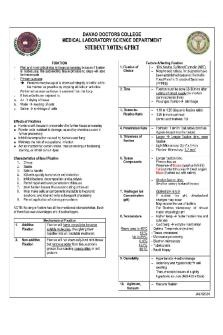Fixation, Tissue Processing and Embedding PDF

| Title | Fixation, Tissue Processing and Embedding |
|---|---|
| Author | Joshua Rupert |
| Course | Microanatomy and Histotechnology |
| Institution | University of Ontario Institute of Technology |
| Pages | 4 |
| File Size | 82 KB |
| File Type | |
| Total Downloads | 366 |
| Total Views | 563 |
Summary
Tissue Processing- Aims to make fixed tissues ready for microtomy.Dehydration- First, the tissue is dehydrated since water doesn’t mix well with wax. - Uses ascending grades of alcohol to dehydrate. This is because immediately placing the tissues in highly concentrated alcohol could damage the tissu...
Description
MLSC-3230, Microanatomy and Histotechnology Tissue Processing -
Aims to make fixed tissues ready for microtomy.
Dehydration -
-
-
First, the tissue is dehydrated since water doesn’t mix well with wax. Uses ascending grades of alcohol to dehydrate. This is because immediately placing the tissues in highly concentrated alcohol could damage the tissue. By the time the tissue is submerged in 100% ethanol it will be fully dehydrated. Ethanol, gives rapid and efficient dehydration. Analytical grade and can be expensive and is regulated by the government. It is clear colourless and flammable. Isopropanol, less expensive than ethanol and not government regulated. Does not cause hardening or much shrinkage of tissue Methanol, equally effective as ethanol but is highly volatile and expensive. Acetone, very rapid and cheaper than ethanol. Good for fatty tissue like breasts and prolonged use of this can cause shrinkage and brittleness of tissues. The time required to dehydrate tissue depends on: o Type of tissue o Size of tissue o Number of pieces of tissue o Volume of reagent o Nature of dehydrating agent Insufficient dehydration will result in mushy or soft tissue that is hard to dissect/cut. Insufficient dehydration will also cause inadequate clearing of the dehydrating agent and inadequate wax infiltration. Tissue can have incomplete dehydration if: o The sections are too thick o There is too much tissue in the cassette o There was inadequate dehydration time o The reagents are expired o The reagent volume is insufficient o The strength of alcohol is incorrect Tissues can also be over dehydrated and become shrunk and hardened. May result in micro-chattering in the tissue when cutting. Over dehydration can be prevented by: o Using small biopsies processed separately o Shortening the dehydration time
MLSC-3230, Microanatomy and Histotechnology
Clearing -
Next, the tissue is cleared to remove the dehydrating agent used for dehydration in a controlled manner. The clearing agent raises the refractive index of the tissue to make them look transparent. Most clearants are organic solvents, like hydrocarbons, and should be miscible with both the dehydrant and the wax for infiltration. Xylene, is the most commonly used clearant in the lab. Clear and inflammable liquid. Prolonged exposure will cause hardness and brittleness. If clearing is inadequate, water will be left behind in the tissue causing similar issues seen in under dehydration. Too much clearing will have effects similar to over hydration. Toluene, similar to Xylene except it does not harden the tissue. Also flammable and toxic. Benzene, not used due to its carcinogenic and toxic properties. Chloroform, highly volatile but inflammable. Slower than Xylene, highly toxic and causes less brittleness. Limonene Reagents, non-toxic, water miscible fixative with a citrus like odour. Can cause small tissue deposits of minerals in tissues. Not often used in the lab due to its smell. Clearing agents are one of the major occupational hazards for histotechnologists. Breathing in Xylene can result in many adverse health effects. Be sure to use Xylene where there is good exhaust ventilation. Do not pour Xylene down the sink because it does not mix well with water.
Infiltration -
-
-
Finally, the tissue is infiltrated with a supportive medium to make it stiff enough to dissect. The molten paraffin wax gives the tissue support during microtomy. The paraffin wax is heated to 2-3 degrees Celsius above its melting point (58-60 degrees). The melting point of paraffin wax is 55-58 degrees and the wax must be monitored for its volume and temperature. Uses 2-3 changes of wax and takes 2-3 hours. Paraffin wax is made of a mixture of hydrocarbons and beeswax, rubber, and plastics. It solidifies through crystallization. Wax filtration is greatly aided using a vacuum. These include: o Spongy tissue (lung and placenta) o Dense tissue (uterus, brain) o Fatty tissue (breast) o Cellular tissue (spleen, lymph nodes) Vacuums are not recommended for very small biopsies or specimens as it can cause over hardening.
MLSC-3230, Microanatomy and Histotechnology -
-
Factors that affect tissue infiltration include: o Solution temperature o Agitation o Vacuum pressure o Fixation of tissues o Tissue type Tissues like bone, skin and CNS tissue require longer infiltration times. Tissues like liver and kidney tissue require less infiltration time. Blood, muscle and fibrous tissue infiltration must be kept minimum to avoid over hardening.
Tissue Processors -
Most reagents used on tissue processors are flammable. As a result, the tissue processing section is placed away from the main lab in a well-ventilated area. Carousel Tissue Processor, the tissue moves around a series of pots of reagents for processing. It is an open system Fluid Exchange Processor, tissues are loaded into the processor in a vacuum sealed chamber. Here, the reagents are sucked in and out of the tissues. This is a closed system. It is easier to apply a vacuum and heat at any stage with this processor. Fluid spills will also be contained since it is a closed system. Alarm systems and programs exist for trouble shooting the machine. It is cleaner and drip free resulting in less carryover of processing reagents. The specimens will not dry out if there is a malfunction Automatic processing usually takes 14-16 hours on both machines. Can be rushed for small biopsies to 2.5-2 hours. Weekends and holidays delay the processing cycle when the staff are not there. Specimens will sit in formalin until the staff return.
Rapid Processing -
Usually only recommended for rushed cases or those with small tissue specimens. Not recommended for fatty or dense tissues. Usually takes 2-5 hours. A microwave can also be used for tissue processing to shorten the processing time. However, this produce noxious fumes and must be placed in a well-ventilated area.
Processor Maintenance -
There typically is a purge cycle on automated processors. It is a two step process that uses Xylol and alcohol rinsing to eliminate any wax build up or organic matter in the system.
MLSC-3230, Microanatomy and Histotechnology -
The typical schedule for reagent rotation and refreshing is o Fresh formalin each day o Remove 70% alcohol and move up rest of alcohols and fresh 100% daily at last alcohol station. o Use fresh Xylol every two days. o Change wax every 3 days....
Similar Free PDFs

Tissue processing
- 6 Pages

Tissue Processing summary notes
- 9 Pages

Embedding and Microtomy
- 5 Pages

Fixation summary notes
- 9 Pages

Tissue and Skin Lab
- 17 Pages

Embedding Summary Notes
- 3 Pages

Bert Embedding - Intro
- 5 Pages

Processing
- 3 Pages

Muscle and Nervous Tissue Lab
- 6 Pages
Popular Institutions
- Tinajero National High School - Annex
- Politeknik Caltex Riau
- Yokohama City University
- SGT University
- University of Al-Qadisiyah
- Divine Word College of Vigan
- Techniek College Rotterdam
- Universidade de Santiago
- Universiti Teknologi MARA Cawangan Johor Kampus Pasir Gudang
- Poltekkes Kemenkes Yogyakarta
- Baguio City National High School
- Colegio san marcos
- preparatoria uno
- Centro de Bachillerato Tecnológico Industrial y de Servicios No. 107
- Dalian Maritime University
- Quang Trung Secondary School
- Colegio Tecnológico en Informática
- Corporación Regional de Educación Superior
- Grupo CEDVA
- Dar Al Uloom University
- Centro de Estudios Preuniversitarios de la Universidad Nacional de Ingeniería
- 上智大学
- Aakash International School, Nuna Majara
- San Felipe Neri Catholic School
- Kang Chiao International School - New Taipei City
- Misamis Occidental National High School
- Institución Educativa Escuela Normal Juan Ladrilleros
- Kolehiyo ng Pantukan
- Batanes State College
- Instituto Continental
- Sekolah Menengah Kejuruan Kesehatan Kaltara (Tarakan)
- Colegio de La Inmaculada Concepcion - Cebu






